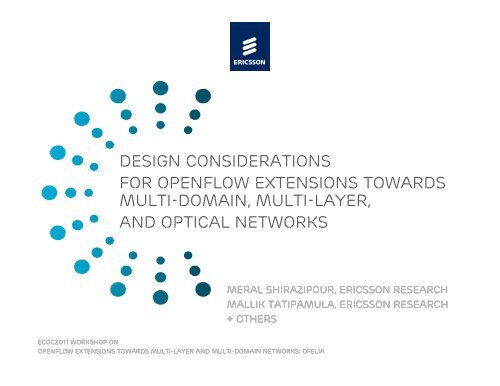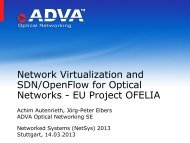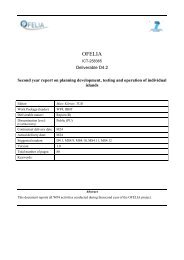Design Considerations for OpenFlow Extensions Towards ... - Ofelia
Design Considerations for OpenFlow Extensions Towards ... - Ofelia
Design Considerations for OpenFlow Extensions Towards ... - Ofelia
You also want an ePaper? Increase the reach of your titles
YUMPU automatically turns print PDFs into web optimized ePapers that Google loves.
<strong>Design</strong> <strong>Considerations</strong><br />
<strong>for</strong> <strong>OpenFlow</strong> <strong>Extensions</strong> <strong>Towards</strong><br />
Multi-Domain, Multi-Layer,<br />
and Optical Networks<br />
Meral Meral shirazipour, shirazipour, Ericsson Ericsson Research<br />
Research<br />
Mallik Mallik Tatipamula, Tatipamula, Ericsson Ericsson Research<br />
Research<br />
+ + Others<br />
Others<br />
ECOC2011 ECOC2011 Workshop Workshop on<br />
on<br />
OPENFLOW OPENFLOW OPENFLOW EXTENSIONS EXTENSIONS TOWARDS TOWARDS MULTI MULTI-LAYER MULTI LAYER AND AND MULTI MULTI-DOMAIN MULTI<br />
DOMAIN NETWORKS: NETWORKS: NETWORKS: OFELIA<br />
OFELIA
Why This Talk?<br />
› To present one of the approaches investigated by<br />
Ericsson Research on how to extend <strong>OpenFlow</strong> to<br />
support multi-layer/multi-technology switches<br />
› To welcome feedback and discuss with other groups<br />
present today, who perhaps are investigating<br />
different approaches<br />
Ericsson Research | September 18, 2011 | Page 2<br />
+
Outline<br />
1. Introduction<br />
2. Control Plane<br />
3. <strong>OpenFlow</strong> Multi-Layer/Multi-Region<br />
<strong>Extensions</strong><br />
Ericsson Research | September 18, 2011 | Page 3<br />
+
Ericsson Research | September 18, 2011 | Page 4<br />
1. Introduction<br />
+
Scope<br />
› The presentation covers<br />
– the components and the basic functionalities of a multi-layer/multiregion<br />
optical (WDM) switch;<br />
– the <strong>OpenFlow</strong> protocol extensions required to manage it from a<br />
remote controller.<br />
› Main starting point references were:<br />
– CCAMP Working Group, Common Control and Measurement Plane<br />
(CCAMP)<br />
– Stan<strong>for</strong>d studies on "<strong>Extensions</strong> to <strong>OpenFlow</strong> Protocol in Support<br />
Circuit Switching" (S. Das)<br />
– Outcomes of Ericsson long term studies and solutions on Packet<br />
Optical Integration<br />
Ericsson Research | September 18, 2011 | Page 5<br />
+
Objective:<br />
packet optical integration<br />
› Benefits of <strong>OpenFlow</strong> <strong>for</strong> Split Architecture have been<br />
proven.<br />
› Why we need extensions <strong>for</strong> ML/MR now?<br />
– Because the current transport networks (mainly based on<br />
SONET/SDH) tend to be too slow to react dynamically to router<br />
traffic shifts<br />
– Packet optical integration is a cost effective practice that will allow<br />
the packet based routers and switches to operate jointly with the<br />
optical network elements.<br />
Ericsson Research | September 18, 2011 | Page 6<br />
+
Packet optical integration<br />
possibilities with <strong>OpenFlow</strong><br />
Multi Multi-Layer/Multi<br />
Multi Layer/Multi<br />
Layer/Multi-Region<br />
Layer/Multi Region<br />
<strong>OpenFlow</strong>:<br />
<strong>OpenFlow</strong>:<br />
<strong>OpenFlow</strong>:<br />
Full GMPLS Support<br />
Ericsson Research | September 18, 2011 | Page 7<br />
Multi Multi-Layer/Multi<br />
Multi Multi Layer/Multi<br />
Layer/Multi-Region<br />
Layer/Multi Region<br />
<strong>OpenFlow</strong>:<br />
<strong>OpenFlow</strong>:<br />
Partial GMPLS Support<br />
with Reuse of Terminology<br />
to designate<br />
1-circuit nesting concept<br />
2-adaptation concept<br />
3-encodings and switch<br />
types<br />
...<br />
...<br />
+<br />
Multi Multi-Layer/Multi<br />
Multi Multi Layer/Multi<br />
Layer/Multi-Region<br />
Layer/Multi Region<br />
<strong>OpenFlow</strong> <strong>OpenFlow</strong> :<br />
:<br />
GMPLS Unaware
Traditional versus <strong>OpenFlow</strong> based +<br />
multi-layer network architecture<br />
C<br />
D<br />
Ericsson Research | September 18, 2011 | Page 8<br />
C<br />
D<br />
C<br />
D<br />
IP/MPLS IP/MPLS<br />
C<br />
D<br />
C<br />
D<br />
IP/MPLS IP/MPLS<br />
IP/MPLS IP/MPLS<br />
IP/MPLS<br />
GMPLS<br />
D<br />
D<br />
C<br />
D<br />
D<br />
IP/MPLS<br />
D<br />
C<br />
D<br />
C C<br />
D<br />
<strong>OpenFlow</strong> ML<br />
Controller<br />
D
<strong>Design</strong> use case scenario<br />
Non-<strong>OpenFlow</strong><br />
GMPLS<br />
CP<br />
<strong>OpenFlow</strong><br />
GMPLS<br />
CP<br />
Ericsson Research | September 18, 2011 | Page 9<br />
<strong>OpenFlow</strong><br />
GMPLS<br />
CP<br />
<strong>OpenFlow</strong><br />
GMPLS<br />
CP<br />
Control Control<br />
Plane<br />
G M P L S<br />
PCE OSPF-TE<br />
RSVP-TE<br />
+<br />
› <strong>OpenFlow</strong> Controller supports<br />
GMPLS.<br />
› <strong>OpenFlow</strong> cloud implements<br />
Multi-Layer and Optical<br />
extensions by following GMPLS<br />
standard encodings but not<br />
necessarily the routing protocols<br />
› The <strong>OpenFlow</strong> controller can talk<br />
to other GMPLS control planes
Ericsson Research | September 18, 2011 | Page 10<br />
2. Control Plane<br />
+
<strong>OpenFlow</strong> <strong>OpenFlow</strong> <strong>OpenFlow</strong> based based Control Control Control Plane<br />
Plane<br />
› <strong>OpenFlow</strong> control plane:<br />
– a transport layer (layer 4) secure channel to connect the node to its<br />
controller (to control and manage the node)<br />
– inside the node, the interface between the data plane and this<br />
channel is implementation specific<br />
Management<br />
Plane<br />
Ericsson Research | September 18, 2011 | Page 11<br />
Control<br />
Plane<br />
Data<br />
Plane<br />
+
Multi-Layer/Multi-Region<br />
Controllers<br />
References: RFC3471 , RFC3945 , RFC4397 , RFC5212 , RFC5339 and RFC6001 .<br />
› Region refers to switching technologies (e.g. PSC or<br />
TDM)<br />
› Layer refers to granularities inside a switching region.<br />
(e.g. in TDM, an OC12 or a VC12 are layers)<br />
› The interfaces on a GMPLS router or node can have one<br />
or many of the minimum six standard switch types:<br />
The interface can be<br />
1. Packet switch capable (PSC),<br />
2. Layer 2 switch capable (L2SC),<br />
3. Time division multiplex capable (TDM),<br />
4. Lambda switch capable (LSC) or<br />
5. Fiber switch capable (FSC).<br />
6. RFC6002 defines a sixth region <strong>for</strong> port switching called data channel<br />
switch capable (DCSC)<br />
Ericsson Research | September 18, 2011 | Page 12<br />
+
Multi-Layer/Multi-Region<br />
Controllers (cont.)<br />
› A node can have a single or multiple switching type<br />
capabilities (Multi-Region node)<br />
› Nodes with multiple switching type capabilities are further<br />
categorized as simplex or hybrid<br />
› This Hybrid is not to be confused with <strong>OpenFlow</strong>-Hybrid<br />
switches which support both <strong>OpenFlow</strong> and non-<strong>OpenFlow</strong><br />
pipelines<br />
› The nodes that have at least one interface that supports<br />
more than one switching capability are called hybrid nodes<br />
› A hybrid node has thus more than one switching elements<br />
(matrices) interconnected internally: L2SC<br />
Ericsson Research | September 18, 2011 | Page 13<br />
Link1, L2SC<br />
Link2, L2SC &<br />
TDM<br />
+<br />
TDM
Multi-Layer/Multi-Region<br />
Controllers (cont.)<br />
› The Interface switching capability (ISC) is the interface’s<br />
ability to <strong>for</strong>ward data of a particular data plane technology<br />
(one of the six regions)<br />
› Internal links connecting the switching matrices in hybrid<br />
switches have finite capacities<br />
› This adjustment capacity in<strong>for</strong>mation is critical <strong>for</strong> path<br />
computation<br />
› This adjustment capacity in<strong>for</strong>mation is available in the ISC<br />
descriptor (ISCD), advertised by routing protocols <strong>for</strong> each<br />
link<br />
› Because, when link bundling is per<strong>for</strong>med ..this in<strong>for</strong>mation is<br />
lost.<br />
– and RFC6001 proposes the IACD extensions <strong>for</strong> GMPLS signaling<br />
Ericsson Research | September 18, 2011 | Page 14<br />
+
GMPLS Encodings<br />
› GMPLS general label <strong>for</strong>mat encoding RFC3471:<br />
8 bits<br />
Encoding<br />
Ericsson Research | September 18, 2011 | Page 15<br />
8 bits<br />
Switch Type<br />
16 bits<br />
General Payload ID<br />
› GMPLS TDM label <strong>for</strong>mat encoding RFC4606:<br />
16 bits<br />
S<br />
4 bits<br />
U<br />
4 bits<br />
K<br />
4 bits<br />
L<br />
4 bits<br />
M<br />
+
GMPLS Encodings (cont.)<br />
› GMPLS WDM label <strong>for</strong>mat encoding RFC6205:<br />
3 bits 4 bits 9 bits 16 bits<br />
Grid Ch.<br />
Spacing<br />
Ericsson Research | September 18, 2011 | Page 16<br />
ID n<br />
› 16 bit value n as a two’s complement integer to compute :<br />
– DWDM Frequency (THz) =<br />
193.1 THz + n * channel spacing (THz)<br />
– CWDM Wavelength (nm) =<br />
1471 nm + n * 20 (nm)<br />
The recent revision of ITU-T Recommendation [G.694.1] has<br />
decided to introduce the flexible grid DWDM technique which<br />
provide a new tool that operators can implement to provide a<br />
higher degree of network optimization than fixed grid systems.<br />
http://tools.ietf.org/html/draft-li-ccamp-flexible-grid-label-00<br />
+
Ericsson Research | September 18, 2011 | Page 17<br />
3. <strong>OpenFlow</strong><br />
Multi-Layer/Multi-Region<br />
<strong>Extensions</strong><br />
+
Needed extensions<br />
› Fundamental difference between circuit switched and<br />
packet switched <strong>OpenFlow</strong>:<br />
– the flow table is not used to lookup circuit flows<br />
– <strong>OpenFlow</strong> controller only responsible <strong>for</strong> setting up the crossconnections<br />
in the switch (<strong>OpenFlow</strong> protocol to establish circuits and<br />
receive stats messages from the switch)<br />
– cross-connections established in a proactive way.<br />
› Possibility: a packet sent to the controller can trigger the<br />
establishment of a new circuit cross-connect (or pre-configured<br />
cross-connects, similar to virtual TE-links in GMPLS).<br />
Ericsson Research | September 18, 2011 | Page 18<br />
+
<strong>OpenFlow</strong> multi-layer multi layer Switch<br />
Packet Flow Table<br />
Packet Switch<br />
Fabric<br />
Packet<br />
Switch<br />
Ports<br />
HW Packet<br />
Processing<br />
Tables<br />
Ericsson Research | September 18, 2011 | Page 19<br />
<strong>OpenFlow</strong> Controller<br />
C C C Table 0 Table 1<br />
Table n<br />
M I M I M I<br />
cct<br />
ID<br />
Group Table<br />
GI<br />
GT<br />
C AB<br />
Circuit Flow Table<br />
Switch Hardware APIs<br />
Switch Hardware Drivers<br />
TDM Switch<br />
Fabric<br />
TDM<br />
Switch<br />
Ports<br />
<strong>OpenFlow</strong> Protocol<br />
in<br />
port<br />
out<br />
port<br />
in<br />
label<br />
WDM Switch<br />
Fabric<br />
Line<br />
Ports<br />
out<br />
label<br />
+<br />
adaptation<br />
actions<br />
add/drop<br />
ports
Example extensions<br />
› New circuit IDs serve as virtual ports to other flows<br />
› Circuit IDs are virtual ports to which incoming packet flows<br />
can be <strong>for</strong>warded<br />
› Other circuit flows can also point to a circuit ID, and hence<br />
represent a circuit hierarchy (the equivalent to GMPLS LSP<br />
nesting)<br />
› Since the circuit flows do not affect the on the fly processing<br />
of packets, they can be implemented in software<br />
Ericsson Research | September 18, 2011 | Page 20<br />
+
Example extensions (cont.)<br />
› Circuit flow entry:<br />
(e.g. encoding,ST,G-PID)<br />
CCT ID in port out port label in<br />
› Circuit Identifier (CCT ID):<br />
Ericsson Research | September 18, 2011 | Page 21<br />
label out encoding,ST,G-PID) (e.g.<br />
– a 32 bit unsigned integer representing the circuit flow-virtual port<br />
› In Port/Out Port:<br />
– a 32 bit unsigned integer representing the incoming/outgoing port.<br />
› In Label/Out Label:<br />
– a 32 bit unsigned integer representing the incoming/outgoing signal<br />
+<br />
adaptation<br />
actions<br />
– the general way is to specify the encoding, switch type and payload ID<br />
(using GMPLS standard encodings as presented be<strong>for</strong>e)<br />
› No adaptation standardized with GMPLS yet - <strong>OpenFlow</strong> actions used<br />
de specify different adaptations
Next Steps<br />
› The extensions need to be fine tuned and precisely specified :<br />
implementation to be completed be<strong>for</strong>e the end of the year<br />
› <strong>OpenFlow</strong> 1.1 has been considered. The extensions may have<br />
to be remapped to new ONF architectural guidelines<br />
Ericsson Research | September 18, 2011 | Page 22<br />
+




